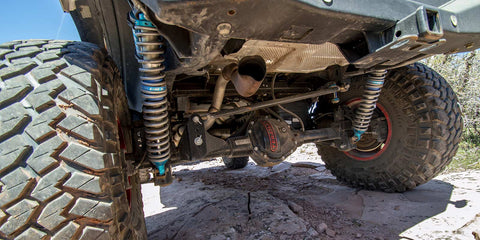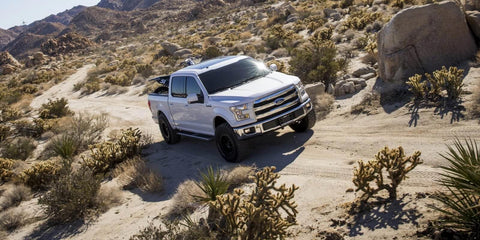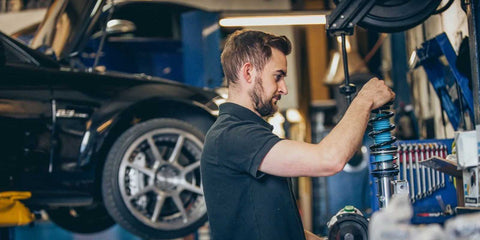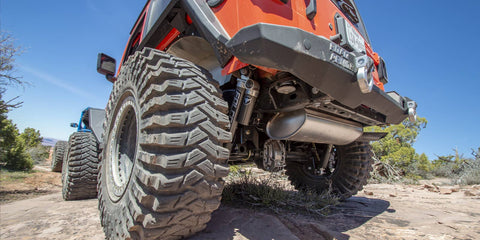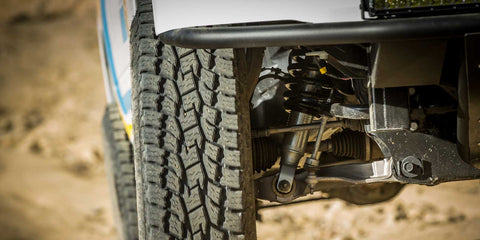Fox 2.0 Coilover & Snap Ring Shocks Review - Toyota Tacoma
Posted by Sean Reyes on
Shock Surplus has tested both the Fox 2.0 Snap Ring shocks and the 2.0 Performance Series Coilovers on the 2nd Gen Tacomas.
At the time of this review, the Tacoma has a steel aftermarket bumper in the front, along with a winch, for a total added weight of about 110lbs, not insignificant and it does affect ride height of the suspension.First Impressions on the Fox 2.0 Coilovers
Right out the gate we could tell the Fox 2.0 was softer than the Bilstein, but this has also been the case for the past few vehicles we’ve done this same comparison for. Going up bumps and driveways was remarkably comfortable and soft. The added weight of the front bumper and winch do add to the comfort, as it works the suspension more, moving the shock through more of its stroke.
Comfort Trade-offs
Coming out of the Bilstein, which are traditionally not very comfortable in the scheme of things, the Fox 2.0 are noticeably more comfortable overall. Better bump compliance by a long shot, meaning they absorb and rebound through speed bumps and driveways a lot differently than the Bilstein.
One small sacrifice that comes with this comfort is a little extra body roll, which you will notice if you’re carrying a bunch of gear or people in the vehicle, like we do sometimes.
Fox vs Bilstein
The easiest way to explain the differences between the Fox 2.0 and the Bilstein 5100/4600 is bump compliance - how the suspension handles potholes, speedbumps, and rocky trails.
- Bilstein is a digressive shock, firm up front and at the beginning ranges of motion, then it smoothes out the more suspension travel that gets used at faster speeds.
- Fox is a linear shock, with a progressive touch, softer up front and at the beginning ranges of motion, and also smooths out during faster speeds and more suspension articulation.
Fox is softer overall, softer on bumps and choppy trails, while still providing improved handling over stock.
Bilstein is firmer overall, providing drastic improvements in handling, but being harsher on small bumps and choppy trails.
There are also some material differences between these shocks; Fox 2.0 is an aluminum body compared to Bilstein’s steel body, bushing material is different, shaft hardness, and Fox allows serviceability (you can rebuild them). But most of that doesn’t matter for people that just want a specific ride.
Off-Road Impressions
The biggest difference on off-road trails, mountainous terrain, and easy forest service roads, is that the Fox 2.0 will ‘eat-up’ more of the choppy stuff. The rocks and chatter will feel softer, similar to what it feels like when you lower your tire’s PSI by 20-30 - everything a bit more subdued.
Will the Fox 2.0 aluminum body make a difference for people? Aluminum is lighter and heat travels through it faster than steel, which means heat from the oil inside is going to transfer to the body of the Fox shock faster, and shed through the surrounding air quicker compared to a steel body shock.Some of you hard-charging drivers will see the benefit of running the Fox compared to Bilstein, as we have experienced fade in the Bilstein 5100 on other vehicles.
Enthusiast & Experts’ Takeaway
Sean and Jeff both have Tacomas here at Shock Surplus.
Sean’s 2006 Tacoma received the Fox 2.0 Performance Series Coilovers after the Bilstein 5100s, and before an Icon Stage 8 Kit, and Old Man Emu BP-51 kit.
Jeff’s 2015 Tacoma received the Fox 2.0 Snap Ring shocks as a testing package when they were first released sometime in 2020, while his Fox 2.5 Factory Series shocks were being rebuilt and retuned.
Both drivers have similar thoughts and conclusions; that being the Fox 2.0 are some of the softest and most comfortable shocks they’ve driven on for their Tacoma. That’s especially true when comparing against the 2.5 options these trucks have seen, which are noticeably sharper and firmer due to their performance standards.
One area that may be lacking for some drivers is the added height gain over a stock vehicle, Fox usually caps their 2.0 shock packages at about +2in of lift over factory height. Sometimes this is adequate enough to fit larger tires, sometimes not, that heavily depends on real tire size and driving habits which may run out of room at full flex in off-road situations. We won't get into that here though.
Where the Fox 2.0 shock shines is for drivers that like to play in the dirt a lot, want as much comfort as possible, and don't mind possibly having to service these shocks 3 or 4 years down the road in order to refresh the components and internals for another go.
2.0 Snap Ring Shocks or 2.0 Coilovers?
The valving of these shocks aren’t technically identical, but they are tuned to provide identical feel to the suspension. In other words if we dyno charted both shocks with their accompanying springs, they would likely show near identical curves.
But since the 2.0 snap rings use factory springs, and the coilovers use a universal spring, the actual valving is different. Small technicality that often goes ignored.
So with ride quality being roughly the same, there are some pros and cons to each.
The snap ring shocks need to be set pre-installation at their specified groove, giving a determined 1” or 2” of lift. Once they’re installed, they’re installed, and it's not recommended to change heights without a new circlip (not provided).
The 2.0 coilovers can be set at various heights through the threaded body, and can technically be preloaded to gain more than 2in of lift, although its not recommended by Fox or us, as it starts to negatively affect ride quality and performance. The benefit of a threaded collar is that you can fine tune the ride heights from passenger side to driver side a lot easier.
The snap ring shocks retail for $250/ea, where the coilovers retail for about $479/ea. So while the coilovers are much easier to install, they’re a lot more expensive. If you’re handy with tools, a coil spring compressor can save you over $400 here.




